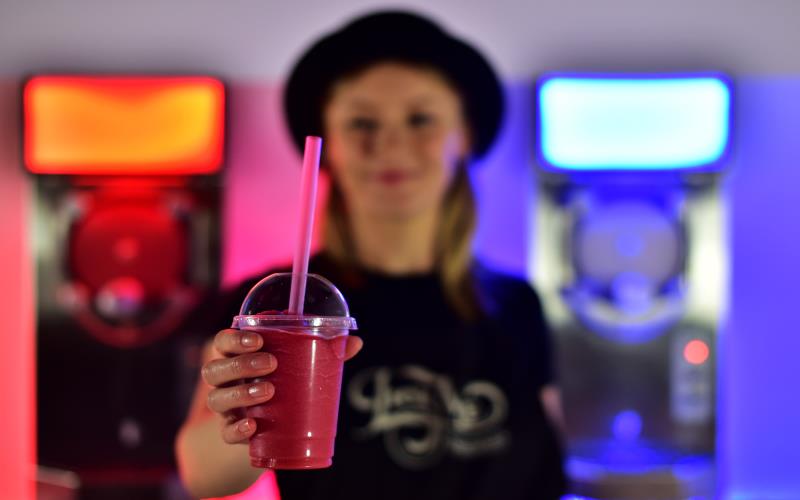Ice-cold slushies remain unparalleled on hot days, offering a delightful escape into a world of refreshment. In this exploration, we will unravel the intriguing science that powers these enchanting machines, which have stood the test of time, satisfying generations with the perfect blend of icy delight and the coveted brain freeze.
What physics principles allow slushie machines to churn out mounds of flavorful frozen fun from liquid origins? How do premium commercial models optimize consistency and accessibility for customers craving a chilling rush? Read on for insider revelations.
The Physics of Slushie Making: How Slushie Machines Work
Freezing and blending process
Slushie devices house a cylinder filled with flavored syrups and water mixtures. Beater bars rapidly churn and scrape the inner walls as powerful refrigeration coils surrounding the chamber drop temperatures. This freezing action causes ice crystals to form, while blending distributes them evenly.
Importance of temperature control
Precision temperature regulation proves critical to yield signature slushy yet scoopable textures. If temperatures dip too low, rock-solid chunks result. Excess warmth produces undesirable liquidity. Digital controls allow minute calibration to help dial in perfection.
Understanding the Mix
Simple syrups sweeten and flavor the primary water content. Thickening agents like guar gum produce a richer body and mouthfeel while slowing separation. Food-grade dyes provide vibrant visual appeal. Natural and artificial flavor extracts infuse custom fruit essences.
Ideally, slushie mixes should feature optimized sugar, chemical stabilizer, and water content to suspend ice crystals uniformly when freezing without solidifying completely or separating during the thaw cycle when served.
Choosing the Right Slushie Machine
Single-bowl vs. double-bowl machines
Basic units feature one chamber for creating a single flavor, while dual-bowl machines allow serving two distinct options. Larger capacity commercial models expedite volume service.
Commercial vs. home use
While compact home units provide novelty, sturdier commercial slush machines support reliable, heavy-duty slush production thanks to metal parts, fan-cooled condensers, and precise digital controls for high-traffic retail outlets.
Maintenance Tips for Optimal Performance
Follow daily cleaning checklists to purge residual syrups and rinse components after closing. Periodic descaling removes mineral buildup within the freezing cylinder. This prevents functionality issues and contamination.
Unopened factory mixes have a generous shelf life at room temperature. Once opened, it is transferred to clearly labeled containers, and refrigerating retains freshness best. First-in, first-out inventory rotation checks wasting expired products.
From failure to freeze to beater bar jams, technicians can rapidly restore order and profits via preventative maintenance. Schedule tune-ups by trusted partners like DSL Canada before peak season, having your unique equipment models at the best performance.
The Role of Temperature
Most slushie machines calibrate around 23-26F for balanced consistency, brisk enough to encourage ample ice crystal formation while preventing a solid frozen block that resists pouring. Digital thermostats allow precision tuning. Specific candy or fruit-based mixes requiring higher sugar concentrations lower the freezing point slightly. This allows dialing machines to be colder by a few degrees for equivalent texture. Likewise, higher alcohol content blends warrant warmer parameters to retain scoopability.
The Science of Brain Freeze
When icy contents contact the roof of the mouth, blood vessels rapidly constrict. Once the cold recedes, accelerated rebound dilation of vessels triggers nearby nerve pain receptors, creating the notorious yet fleeting brain freeze sensation. According to research, anatomical variances in palate structure/vasculature and individual differences in pain tolerance thresholds account for brain freeze sensitivity among the general public.
Fun Facts About Slushie Machines
The concept traces its origins to 1940s lemonade vendors simply freezing seasoned syrup solutions overnight to sell as novelties. Commercial machines emerged in the 1960s following advances in refrigeration and blending systems tailoring drink consistency specifically for mass retail spaces like concession stands. Contemporary updates encompass stainless steel sanitary construction, precise digital thermostats, and built-in stirring mechanisms, allowing hands-free processing for simplified operations and profits. New express models produce single servings within minutes by perfectly pre-blending syrups and water for push-button pouring.
Conclusion
In summary, expert engineering harmoniously unites advanced refrigeration, calibrated temperature control, high-speed mixing, and custom syrup formulation into reliable delivery systems adored by frozen treat fans everywhere, thanks to physics.
Next time you savor syrupy chilled mouthfuls, appreciate the meticulous craftsmanship, ensuring balanced consistency and flavors. For the finest commercial equipment satisfying seasonal customer demand, look no further than DSL Canada’s expansive selection of new and used models supported by the industry-leading service network to resolve operational hiccups rapidly. Beat the heatwave funk in profitable frozen style.

